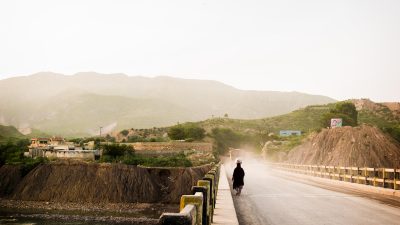China’s Deadliest Disaster That Shook The World
The Tangshan Earthquake, which struck on July 28, 1976, is one of the most catastrophic seismic events in modern history. With a magnitude of 7.5 on the Richter scale, it devastated the city of Tangshan, located in northern China, just 120 kilometers east of the capital, Beijing. The earthquake’s sheer strength and the speed of its onset made it impossible for residents to prepare or evacuate. Over 242,000 people are officially recorded as having died, though estimates suggest the number could have reached as high as 700,000 or more. The tremor caused the collapse of nearly every building in Tangshan, including factories, homes, schools, and hospitals, leaving the city in ruins. Despite the magnitude of the disaster, the Chinese government initially downplayed the severity of the event, leading to a delay in official rescue operations. However, as the extent of the destruction became clear, both local and national efforts were mobilized for relief. The tragedy not only shocked the nation but also became a defining moment in China’s history, shaping both its disaster response strategies and social policies for decades. This earthquake stands out not only for the high death toll and destruction but also for its far-reaching effects on China’s political, social, and economic landscape during a time of major transitions.
Geographical Context
Tangshan, a city in Hebei Province, is located in northern China, approximately 120 kilometers (75 miles) east of Beijing. Situated on the North China Plain, Tangshan had a population of about 1.1 million people in 1976, making it one of the most populous industrial cities in China at the time. The city is positioned near several fault lines, and its proximity to the Tangshan Fault made it highly susceptible to seismic activity. The region, historically prone to earthquakes, experienced frequent tremors, but none as destructive as the one that occurred in 1976. The earthquake struck early in the morning, catching the majority of the population unaware, and its intensity was felt as far away as Beijing and Tianjin. The surrounding areas were also severely affected, with thousands of aftershocks following the main event, further hampering rescue operations and causing additional damage. The earthquake’s geographical location and the fact that Tangshan was a key industrial hub made its devastation all the more impactful, as the collapse of factories and transportation systems hindered both relief efforts and recovery in the weeks following the event.
The Earthquake: Date, Time, and Magnitude
- Date and Time:
The Tangshan Earthquake occurred on July 28, 1976, at 3:42 AM local time. It struck without warning during the early hours of the morning, when many people were still asleep, which contributed to the high number of casualties. - Magnitude:
The earthquake registered a magnitude of 7.5 on the Richter scale, making it one of the strongest earthquakes in the 20th century. The intensity of the quake caused massive destruction, as buildings and infrastructure collapsed in a matter of seconds. - Duration of the Shock:
The main shock lasted only 15-20 seconds, but in that brief period, the damage was catastrophic. The region experienced severe shaking, which led to the collapse of almost all structures in Tangshan, including industrial buildings, homes, and public facilities. - Epicenter:
The epicenter was located near Tangshan, specifically in the Tangshan Fault zone. This region is known for being seismically active, which made it vulnerable to such a powerful quake. - Aftershocks:
Following the main tremor, numerous aftershocks continued for days, with the largest aftershock hitting just 16 hours later. These aftershocks caused further destruction, complicating rescue and relief efforts. - Seismic Wave Propagation:
The earthquake’s seismic waves were so powerful that they were felt across a wide region, including Beijing, Tianjin, and even parts of Shandong Province. In fact, the tremors reached as far as Japan, highlighting the strength and wide-reaching impact of the earthquake. - Impact on Tangshan:
Tangshan experienced the most intense shaking at the epicenter, with most buildings in the city either collapsing or being severely damaged. The city’s infrastructure, including roads, railways, and utilities, was almost entirely destroyed, further hampering rescue efforts.
Pre-Earthquake Conditions
Leading up to the Tangshan Earthquake, there were no clear, widely recognized warning signs, making the event particularly devastating. While earthquakes are common in the region, with periodic tremors recorded throughout history, none had been as severe or as destructive as the one in 1976. In the weeks and months prior to the earthquake, there were reports of minor tremors and ground movements in the region, but these were generally dismissed as normal seismic activity. Some local residents and workers reported unusual phenomena, such as strange animal behavior and fissures appearing in the ground, which are sometimes thought to precede earthquakes, but these signs were not seen as serious enough to cause concern at the time. Additionally, while the Tangshan Fault was known to be an active fault line, the city itself was not prepared for an earthquake of this magnitude. The lack of effective earthquake monitoring systems and the absence of public earthquake education meant that the population had little to no awareness of the potential risks. As a result, when the earthquake struck, most people were caught completely off guard, leading to catastrophic consequences.
The Immediate Impact
The immediate impact of the Tangshan Earthquake was catastrophic, with the city of Tangshan suffering near-total destruction. The tremor, which lasted only 15-20 seconds, leveled nearly every building in the city. Approximately 242,000 people were officially reported dead, but estimates suggest the true death toll could be as high as 700,000. Thousands of others were injured, many of them critically. Residential buildings, factories, schools, and hospitals collapsed, leaving people trapped under rubble and unable to access emergency services. The transportation and communication infrastructure was also completely destroyed, hindering rescue operations. The earthquake also caused massive disruptions in the surrounding regions, including Beijing and Tianjin, where buildings were damaged and vital services were disrupted. The combination of rapid destruction, high casualties, and the initial lack of effective response made the earthquake one of the deadliest in history.
Rescue Operations
Rescue operations began shortly after the earthquake but faced significant challenges due to the scale of the destruction. Local authorities were overwhelmed, and it took several hours before any large-scale rescue efforts were organized. Initially, the Chinese government did not acknowledge the full extent of the disaster, which delayed international aid. However, once the scale of the damage became clear, Chinese military units and local volunteers mobilized to search for survivors amidst the rubble. Rescue teams faced extreme conditions, including aftershocks, collapsed infrastructure, and lack of equipment. Foreign aid also began to arrive, with Japan, the Soviet Union, and other countries offering assistance in the form of medical supplies and rescue teams. The efforts were heroic, but due to the scale of the destruction, only a fraction of those trapped under debris were rescued in time.
Survivors’ Stories and Accounts
The stories of those who survived the Tangshan Earthquake are both heart-wrenching and inspiring. Many survivors recall the terrifying moments of the earthquake, with entire buildings collapsing around them. Li Hong, a factory worker, vividly remembered being trapped under rubble for several days before being rescued. Survivors faced not only the trauma of the earthquake but also the psychological toll of losing loved ones and witnessing the devastation of their city. One of the most touching stories is that of Chen Jing, who was trapped under debris with her two young children. After days of rescue operations, she was eventually pulled out, but tragically, her children did not survive. These personal accounts highlight the bravery and resilience of the Tangshan people, who, despite immense hardship, found strength in the face of overwhelming adversity.
Government Response and Recovery
The Chinese government’s response to the Tangshan Earthquake was initially slow and somewhat disorganized. The Chinese leadership, including Chairman Mao Zedong and Premier Zhou Enlai, was initially focused on minimizing the political impact of the disaster. The official narrative downplayed the scope of the devastation, which delayed international aid and assistance. However, as the magnitude of the disaster became apparent, the government quickly shifted gears. Rescue teams and military personnel were deployed to the affected areas, and the government began coordinating recovery efforts. Over the following years, the city of Tangshan was rebuilt with the help of national resources and international aid. Despite the initial political challenges, the recovery effort eventually showcased the resilience of both the Chinese government and its citizens.
Economic Consequences
The Tangshan Earthquake had severe economic consequences for China, both in the short and long term. The city of Tangshan, a major industrial hub, was almost completely destroyed. Factories, coal mines, and railways were severely damaged, leading to a halt in production and supply chain disruptions. The immediate financial losses were staggering, with an estimated cost of billions of dollars (in 1976 terms). The economic impact was not limited to Tangshan; the destruction of key infrastructure also disrupted regional and national economies. Recovery was slow, and the rebuilding process drained China’s resources, which were already stretched thin due to other economic challenges. In the longer term, however, the government’s large-scale investment in reconstruction helped revitalize the region’s economy and contributed to the development of modern industrial sectors.
Health and Environmental Impact
The health and environmental impact of the Tangshan Earthquake was far-reaching. In the immediate aftermath, thousands of people were injured, and many others succumbed to diseases related to unsanitary conditions caused by the destruction of infrastructure. Medical facilities were overwhelmed, and basic supplies like food and clean water were in short supply. Disease outbreaks, including cholera and typhoid, were common in the weeks following the disaster. The environmental impact was also significant, as the earthquake caused landslides, altered river courses, and destroyed large areas of farmland. The destruction of industrial sites and the widespread use of chemical products further contributed to environmental degradation. Over time, these health and environmental challenges slowed the recovery process and required additional efforts from both local authorities and international organizations.
International Reactions and Aid
The international response to the Tangshan Earthquake was swift and compassionate, despite the political context of the time. As news of the disaster spread, governments and international organizations mobilized to provide aid. Countries like Japan, the Soviet Union, and the United States sent teams of medical experts, supplies, and funds to assist with the recovery efforts. International aid was a crucial part of the rescue operation, as Tangshan’s resources were quickly exhausted. Red Cross organizations from various countries also played a vital role in providing humanitarian relief. Despite initial reluctance by the Chinese government to accept foreign assistance, international support was instrumental in alleviating some of the suffering caused by the earthquake. This response demonstrated a global sense of solidarity in the face of a disaster of such unprecedented scale.
Lessons Learned and Modern Preparedness
The Tangshan Earthquake brought about significant changes in China’s approach to disaster preparedness and response. In the years following the tragedy, the government invested heavily in improving seismic research, early warning systems, and emergency response protocols. Lessons learned from Tangshan have informed China’s handling of subsequent earthquakes, including the 2008 Sichuan Earthquake. The country implemented stricter building codes, ensuring that new constructions could withstand seismic activity. Additionally, the earthquake prompted improvements in public awareness about disaster preparedness, including better training for both citizens and local authorities. The lessons from Tangshan have helped China become more resilient in the face of natural disasters.
Tangshan Today: Rebuilding and Resilience
Today, Tangshan is a thriving city, having rebuilt much of its infrastructure and economy since the devastation of 1976. Modern skyscrapers and industrial complexes now stand where once there was rubble. The city’s population has grown, and its economy is stronger than ever, with industries such as steel production, coal mining, and machinery manufacturing. The recovery process has been a symbol of resilience, not only for Tangshan but for all of China. The city’s experience has also become a model for disaster recovery, with lessons shared globally about the importance of preparedness and community resilience. The spirit of the people of Tangshan, who rebuilt their homes and lives from the ruins, continues to inspire.
FAQs
- How many people died in the Tangshan Earthquake?
Approximately 242,000 people were officially confirmed dead, though the total death toll is believed to be as high as 700,000. - What was the magnitude of the earthquake?
The earthquake had a magnitude of 7.5 on the Richter scale, making it one of the most powerful earthquakes of the 20th century. - How did the Chinese government respond to the earthquake?
The Chinese government initially downplayed the extent of the disaster, which delayed rescue and relief efforts. However, once the severity became apparent, national and international aid was mobilized, and extensive recovery efforts were launched. - What were the long-term effects of the earthquake on China?
The earthquake had significant economic and social impacts, but it also led to improved seismic research, disaster preparedness, and better building codes in China. The recovery process showed the resilience of the Chinese people and their ability to rebuild after such a devastating event.
Reference:
USGS- The 1976 Tangshan earthquake
Wikipedia- 1976 Tangshan earthquake
PUBS- The July 27, 1976 Tangshan, China earthquake—A complex sequence of intraplate events
http://news.bbc.co.uk/onthisday/hi/dates/stories/july/28/newsid_4132000/4132109.stm
BBC- 1976: Chinese earthquake kills hundreds of thousands
YT links:
1976 , Tangshan Earthquake
Over 242,000 killed, things you might not know in Tangshan earthquake of 1976
PICS:




